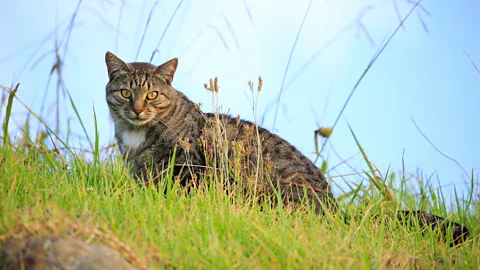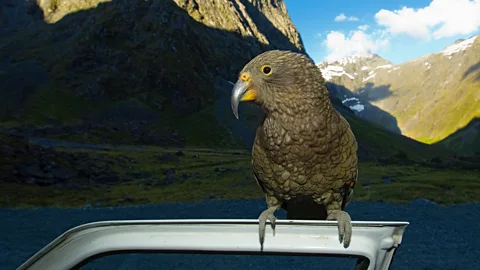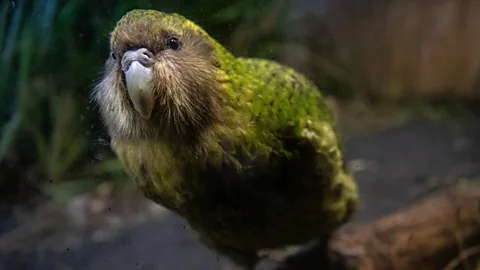Should New Zealand cats be kept indoors?
 Hanh Pham/EyeEm/Getty Images
Hanh Pham/EyeEm/Getty ImagesNew Zealand's remarkable birdlife evolved on a land without apex predators. Introduced cats have decimated their numbers. New Zealanders may have to change the way they keep cats.
The Lyall's wren was, for many generations, perfectly attuned to New Zealand's remote mammal-less landscape at the bottom of the South Pacific Ocean.
When New Zealand was finally settled by people – ancestors of the Māori who first arrived sometime in the 13th Century – the small, flightless bird found itself ill-prepared for predators like the Polynesian rat.
By the time European settlers arrived in the early 19th Century, the bird had been wiped out on the two main islands. Only one small population was left on Stephens Island, an island separated from the northern tip of the South Island in New Zealand's Cook Strait.
The Lyall's wren is only known to European science thanks to examples gathered after a lighthouse was set up on the island in 1894. Lighthouse keepers brought cats – one of whom is thought to have been called "Tibbles" – which quickly produced a feral population. Within a year, cats had wiped out Lyall's wren; one brought back to the lighthouse by the keeper's cat in February 1895 was the last example to be seen.
New Zealand's idiosyncratic native bird species filled every evolutionary niche during the tens of millions of years of isolation they enjoyed since the landmass separated from the supercontinent Gondwana. Along the way many of them, such as the kiwi which has become the nation's emblem, "forgot" how to fly. When mammals arrived, New Zealand's native bird species were suddenly faced with threats evolution just hadn't prepared them for.
New Zealand has, latterly, tried to redress this. Alongside bird conservation programmes that have been running for more than a century, its Predator Free 2050 campaign aims for the eradication of introduced pests such as rats, stoats, ferrets, weasels and possums. But one animal has been left off the list – feral cats. Campaigners say that's a mistake, and that they should be added.
Conservation groups are pushing for a national cat management act – the first of its kind to be rolled out for an entire nation. But there are wider questions for the hundreds of thousands of New Zealand households that are home to a cat; should New Zealand's cats be kept away from the outside world?
---
New Zealand's rate of cat ownership is the highest in the world – nearly half of all households have at least one cat. My sister, for instance, lives in a cul-de-sac a half-hour's drive north of New Zealand's capital Wellington. It's the perfect place for children and cats, with quiet roads to play in. Her family own a cat called Zoe, and almost all the surrounding neighbours own one too. The cats, with large gardens to explore along with acres of scrub and native bush to prowl on the hillsides nearby, are out more often that they're inside.
You might also like:
New Zealanders, with lots of space and a love of the outdoors, often let their cats roam free, at least during the day. The cats in my sister's street are, like 88% of the country's companion cats, all neutered or spayed. While this rate is high by international standards, it is by no means complete. And in some, cats may well have had a litter of kittens before they are neutered. Even if only 12% of its domestic cat population is breeding, that could steadily add to the stray or feral population.
 JordiStock/Getty Images
JordiStock/Getty ImagesNo-one knows how exactly many feral cats there are in New Zealand, but the number could be as high as 2.5 million – almost one wild cat for every two people in the country. Feral cats have colonised every environment, from the mountains to the coastal areas, says Amelia Geary, a regional conservation manager for the Royal Forest and Bird Protection Society.
And if the estimates are accurate, it means there are a lot of hungry mouths prowling the countryside. Cats are natural, patient hunters, and have had an outsized effect on New Zealand flightless bird population.
"They've directly contributed to the extinction of 11 bird species, and possibly contributed to the extinction of 10 more," Geary says. "And now, those more vulnerable species have gone they've moved on to eating everything else – lizards, and vertebrates, and endangered native bats.
"There is evidence of them eating penguins," she adds. "They're up in the mountains eating endangered lizards. They're widespread. And in this country, unlike the UK, when a species goes extinct like the Eurasian crane, we don't have the luxury of just slipping over to Germany to get more birds to then start up a new population. You know, extinction is forever in this country."
The Royal Forest and Bird Protection Society has in the past estimated that feral cats could be responsible for the deaths of as many as 1.1 million native birds every year, alongside tens of millions of introduced birds. They say cat predation compounds that by rats and mustelids like the stoat, which was introduced by British settlers in the 19th Century. Many of the more vulnerable birds, like the ground-dwelling nocturnal parrot, the kākāpo, survive only because breeding populations were moved to predator-free islands before it was too late.
It is not just small or slow-moving birds now at risk. Cats are now partly blamed for a huge drop in numbers of kea, a strong alpine parrot which sometimes preys on sheep lambs in New Zealand's snowy high country. It is thought warmer winters thanks to climate change are allowing cat litters to survive over winter in these areas.
New Zealand's birds are particularly vulnerable to cat predation, says Jessi Morgan, the chief executive of the conservation group Predator Free New Zealand Trust. Many are flightless, they nest and fledge on the ground and some exude a strong, mammal-like odour which cats can pick up. "Cats are apex predators here," she says.
Morgan recently hiked along one of New Zealand's most popular – but remote – hiking tracks, the Milford Trek, and was surprised to spot cats roaming there too. "We had to get there by boat, and the only way a cat could get there is over this huge pass," she says. "It's quite terrifying to see them in this environment."
The effect cats have isn't just limited to predation – the recent boom in feral cat populations is even being felt in New Zealand's marine environment. Toxiplasma, or toxo, is a parasite carried by feral cats which has been implicated in the deaths of some of New Zealand's indigenous dolphin species, Geary says. "They are indirectly impacting our endangered dolphins, Maui and Hector's dolphins, because they are washing up on the beach infested with toxoplasmosis and the only host of toxo is cats. The oocysts of toxoplasmosis can be dormant in the soil for years." If a cat defecates near a stream which then floods, the cysts can be swept out to sea.
What various conservation groups are pushing for is not just control of feral cat populations; they want New Zealand's cat owners to rethink how their cats live, and what effect they might be having on the country's wider natural environment. In the last decade, conservation and cat welfare groups have tried to steer public debate to consider all cat populations as a factor in bird predation, and are campaigning for the government to introduce a national cat act which will require all domestic cats to be microchipped and neutered.
 Jason Hosking/Getty Images
Jason Hosking/Getty ImagesIf New Zealand eventually does have a cat act, it will be the first of its kind at a national level. The Cat Act 2011, which requires the "identification, registration and sterilisation of domestic cats" is an act at state rather than federal level. Only West Australia currently employs it, though Tasmania and the Australian Capital Territory also enforce an earlier cat management act from 2009.
Cat populations overlap and intersect with each other, Christine Sumner, a scientific officer at the Royal Society for the Prevention of Cruelty to Animals (RSPCA) in New Zealand, says. "From one end of the spectrum, feral cats, these are wild animals that do not rely on us at all and are self-sustaining," she says. "On the other end of the spectrum, and in the middle, is this range of what are called stray cats. And these can be semi-owned community cats that are friendly, but don't have one particular home to very unsocialised stray cats that the ones that don't want anything to really do with us, but still depend on us somewhat." These populations interact, and both come into contact with pet cats as well.
"In this country, cats are one fluid population," says Geary. "Because owned cats can become stray through neglect or unmanaged litters that then over time will join the feral population. And equally feral cats can, if they're hungry, come in and join the street populations, and then they can get caught and rehomed. So it's one massive, contiguous population, that at the moment is largely unmanaged. We need to have some serious discussions about how we stop that flow."
Feral cats have already been eradicated from some of New Zealand's offshore islands, which serve as breeding "lifeboats' to help build up bird populations to restock habitats on the mainland. Bringing down cat numbers on New Zealand's North and South Islands is far more of a challenge. The country's vast wilderness offers many places to hide.
New Zealand's Department of Conservation – the government department which protects some 30% of New Zealand's landmass – has already seen success with some limited cat eradication programmes. In Northland, the Kiwi Coast programme has brought together more than 200 community groups to remove pests from the endangered kiwi's habitat. In 2021 alone, the programme removed more than 1,500 feral cats, alongside almost 100,000 other pests.
More have focused on other feral cat populations targeting more of New Zealand's protected species, such as the black stilt, the rarest wading bird in the world.
New Zealand's conservation groups are clear about one thing – they are not asking people to give up their cats, nor are they pushing for a ban on domestic cats, a move that would obviously prove controversial. Cat lovers turned on Morgan's father Gareth, a former politician who set up the Predator Free New Zealand Trust, when in 2013 he called for more management of domestic cats.
The first priorities in proposed cat management plans are to microchip and neuter as many of New Zealand's pet cats as possible. Microchipping means companion cats picked up on the streets are more likely to be reunited with owners, and less likely to become strays and potentially add to a feral cat population.
 Liu Yang/Getty Images
Liu Yang/Getty ImagesDesexing, says Geary, will ultimately have the most effect. "That's the first hurdle to stop unwanted breeding… because the welfare organisations are constantly screaming out for people to take unwanted cats, you know, it's a problem for everybody. And if we can keep on top of the breeding, that whole stray-feral-owned cat circle can be slowed right down. That paves the way for the hinterland to start getting some active management." Geary adds there also need to be subsidies to help lower-income owners access de-sexing.
Cat owners argue their pets are not doing the damage to wildlife populations that feral cats are as they are often fed with enough food. But wildlife campaigns say they still play a role.
"Stray cats and companion cats, we know relatively little about the impact they have on native wildlife," Sumner says. "And importantly, they're part of an ecosystem. It's like pulling a thread of a quilt."
But regulating companion cat ownership may not stop with neutering. Cat owners could also be asked to consider keeping their cats indoors – away from the temptation of hunting and killing birdlife.
Cats having choices is really important to cat owners," says Sumner. "And one of a big way that cat owners provide choice is being able to come and go indoor outdoors." Understanding that link between the cat and their owners, she says, is vital to help people come to terms with the idea that their pet might be better off with a life indoors. "We want to see more people keeping their cats at home, whether we want to protect the cats' welfare or protect wildlife. How can they still give their cats choices while keeping them at home?"
She cites examples like a "catio" where the cats have "a screened-in patio, all these places to climb, and I put a hammock where the sun comes in".
"I think it's important show that cats can enjoy the spaces and have a good life at home," she adds.
Even just keeping cats in overnight – despite their caterwauling to be let out – can make a difference, says Sumner. "We know other cat owners do this: dusk means it's time to eat and you're coming inside for the night. We think that's a positive step forward. But we think we need to go beyond that as well." Indoor cats are also much less likely to incur expensive vet bills from fights with other cats or being hit by cars.
 Mike Evertzen/500px/Getty Images
Mike Evertzen/500px/Getty ImagesThere are other recommendations, too: feed cats a protein-heavy diet and play with them regularly to stop them getting bored as cats sometimes hunt for stimulation as well as food.
A national cat act is still a long way off – a petition is currently being heard by a select committee in New Zealand's parliament – but there is growing consensus among conservation and animal welfare groups who a decade ago might have been at opposite ends of the debate. "Ten years ago, the discussion was very polarising," says Geary. "And people thought that if you needed to manage cats, it means getting rid of your pet. But now through all of my engagement in discussions about regulation, everyone's united. It's heartening to see how much support there is for regulation of owned cats in particular.
"People acknowledge their own cats are part of the problem. But also they want to do what's best for their cat and actually, managing owned cats is good for cats," Geary says.
"We have to be really conscious here that cats are a really important companion animal," says Morgan. "And so we can't afford to create an us-and-them conversation. Many conservationists love animals and own cats. And so really what the conversation is, is changing the meaning of what a responsible cat owner is. Typically, people have bought cats because they've thought of them as relatively low-maintenance pets and you can leave them a bowl of food and go away for a week and just let them roam and they're self-sufficient. We've just got to change our mindset."
--
